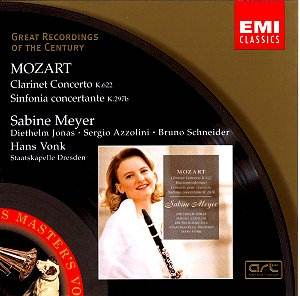Comparisons:
Clarinet Concerto (Prinz/Böhm/DG Ė Brymer/Davis/Philips)
Sinfonia Concertante (Orpheus/DG Ė Warren-Green/Virgin Classics)
The extensive "Great Recordings of the Century"
series from EMI has included illustrious artists such as Bruno
Walter, Elisabeth Schwarzkopf, Dennis Brain and Yehudi Menuhin.
The Mozart disc under review features Sabine Meyer and Hans Vonk,
and nobody would claim that either of them has attained the great
esteem afforded most other artists in the series. However, I can
confidently state that their performances of the Clarinet Concerto
and Sinfonia Concertante are among the best versions on record
and fully deserving of the exalted status given by the folks at
EMI.
Mozart composed his Clarinet Concerto just a
few months before his death while he was also working on his Requiem.
The Concerto was written for his good friend, the clarinettist
Anton Stadler, and displays Mozart at the peak of his creative
powers. The concise architecture, exceptional interaction between
solo instrument and orchestra, and an abundance of inspired themes
seem to wing their way to the listener on a non-stop basis. The
work is considered Mozartís finest wind concerto, and Iíll take
it further and declare it the best wind concerto in the entire
world of classical music.
In addition to the traits mentioned above, Mozartís
Clarinet Concerto has such great majesty and warmth from within
that it melts oneís heart and offers a comfort uncommon in other
musical works. For many years, my standard for the Clarinet Concerto
has been the early 1970s Karl Böhm recording featuring Alfred
Prinz and the Vienna Philharmonic Orchestra. Böhm uses slowish
tempos that allow listeners to savor Mozartís music. The majesty
and warmth his performing forces exude are absolutely sublime.
If a quicker version is preferred, one need look no further than
to the Philips recording conducted by Sir Colin Davis and featuring
Jack Brymer on clarinet. This version isnít as comforting as the
Böhm, but it does highlight the excitement of the outer movements.
Hans Vonk paces his performance in a manner similar
to Davis, and both offer full-bodied interpretations. Any substantial
difference is due to Sabine Meyerís playing a basset clarinet,
which is the instrument that Mozart conceived for the work. Darker
and rounder in tone than a modern clarinet, Meyer executes her
role splendidly in bringing out both the exuberance and poignancy
of the music. Although the Böhm version remains my favorite,
Meyer and Vonk fully match the Davis recording.
A look at the history of the Sinfonia Concertante
tells us once again that movies may be magic, but they arenít
necessarily accurate with the facts. In the Academy Award winning
movie "Amadeus", Mozart humiliates the Italian composer
Salieri in front of the Emperor of the Austro-Hungarian Empire
by indulging himself in variations on a simple theme wrote by
Salieri to greet Mozart. In real life, Mozart humiliated the ĎKingí
of the Parisian Sinfonia, Giuseppe Maria Cambini, by inserting
his own musical ideas into a Cambini quartet in court performance.
Although Cambini publicly praised Mozartís input,
he did everything he could in private to make Mozartís residence
in Paris an unpleasant one. When Mozart departed France, he left
behind the score to the Sinfonia Concertante and it disappeared.
Years later it re-emerged with authorship unclear.
Personally, I find it hard to not consider the
work Mozartís, because it carries a host of his trademarks such
as balance of architecture, exquisitely flowing lines, concise
musical arguments, and a wealth of melodic invention. Further,
the exceptional highlighting and interaction of the solo instruments
in the 3rd Movement Andantino con variazioni, if not
from the pen of Mozart, would have to be from his clone.
Sabine Meyer and Company again offer superb performances
totally up to the standards of the lovingly warm Orpheus Chamber
Orchestra and the clean and exciting version from Warren-Green.
Each of the three recordings conveys the rhythmic energy and bounce
of the outer movements and the elegance and charm of the Adagio.
The EMI soundstage is perfectly balanced with
ample richness and depth. If the coupling appeals, I canít think
of a more rewarding set of performances than Sabine Meyerís that
justly deserves its inclusion in EMIís "Great Recordings
of the Century" series. Just keep in mind that Karl Böhmís
recording of the Clarinet Concerto would rate some attention as
perhaps the greatest recorded performance of the last century.
Don Satz
